What Does a Skull Symbolize Spiritually? Transformation!
The skull symbolizes various spiritual concepts including transformation, the impermanence of life, and the cycle of life and death. Its representation in different cultures emphasizes these meanings, making it a powerful spiritual icon.
Spiritually, the skull is a reminder of our mortality, urging us to live with mindfulness and purpose. It encapsulates the idea that physical existence is transient, and in doing so, it can represent significant spiritual transformation.
For instance:
- In some Eastern traditions, skulls are symbols of enlightenment, as they signify the shedding of the ego.
- In Western iconography, skulls often appear as memento mori, artifacts meant to remind us of our mortality.
The skull, an emblem of our finite nature, prompts introspection and the embrace of life’s fleeting beauty, urging us to find deeper meaning and connection.
The skull is a multifaceted symbol in spiritual contexts, signifying mortality, transformation, and the life-death cycle. Its pervasive presence in different cultural rituals and art forms points to a universal recognition of its profound meanings.
This emblem serves as a stark reminder of life’s transient nature while also symbolizing the possibility of spiritual growth and renewal.

Key Takeaway
The Origins of Skull Symbolism
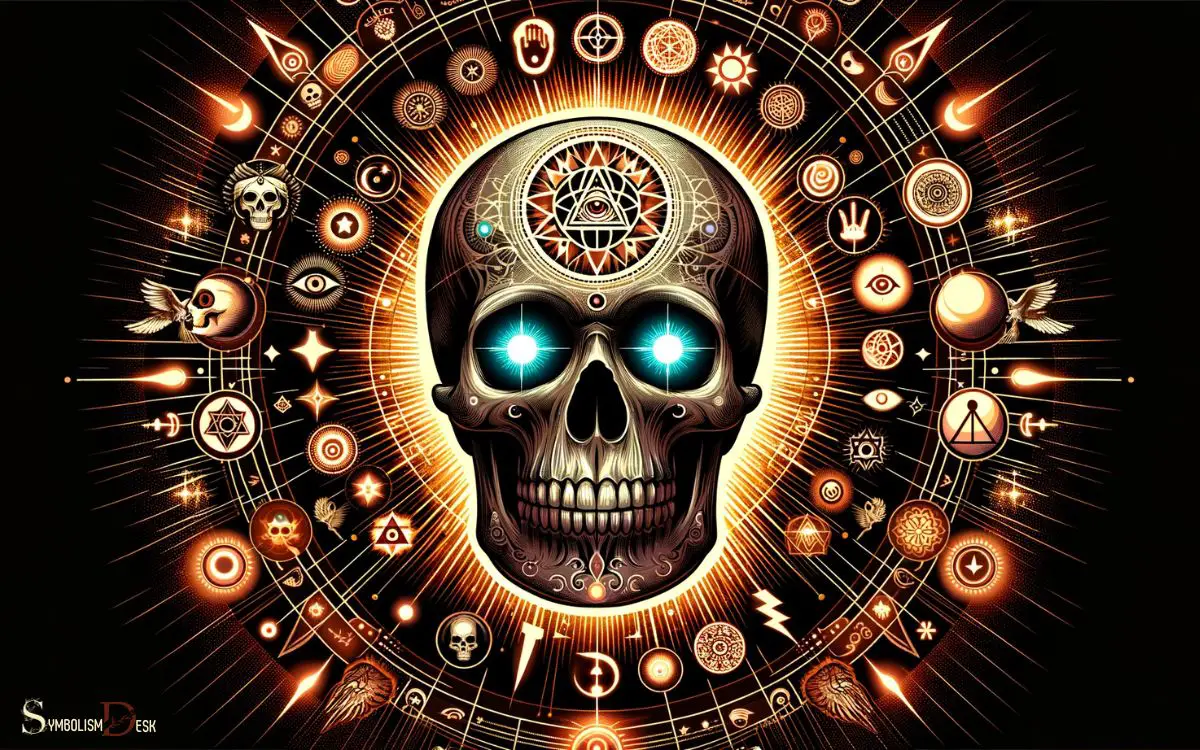
The origins of skull symbolism can be traced back to ancient cultures and various spiritual traditions.
- In many ancient societies, the skull was seen as a powerful symbol of mortality, the seat of intelligence, and the vessel of the soul.
- For instance, in Hinduism, the god of death, Yama, is often depicted holding a skull, representing the mortal nature of humans.
- Similarly, in Tibetan Buddhism, the skull cup, known as kapala, is used in rituals to symbolize the impermanence of life and the transformative power of spiritual practice.
- In Celtic traditions, skulls were believed to have protective powers and were often used as symbols of strength and power.
- Across civilizations, the skull has held deep spiritual significance, representing the cycle of life, death, and rebirth, and serving as a reminder of the transient nature of human existence.
Skull Symbolism in Ancient Cultures
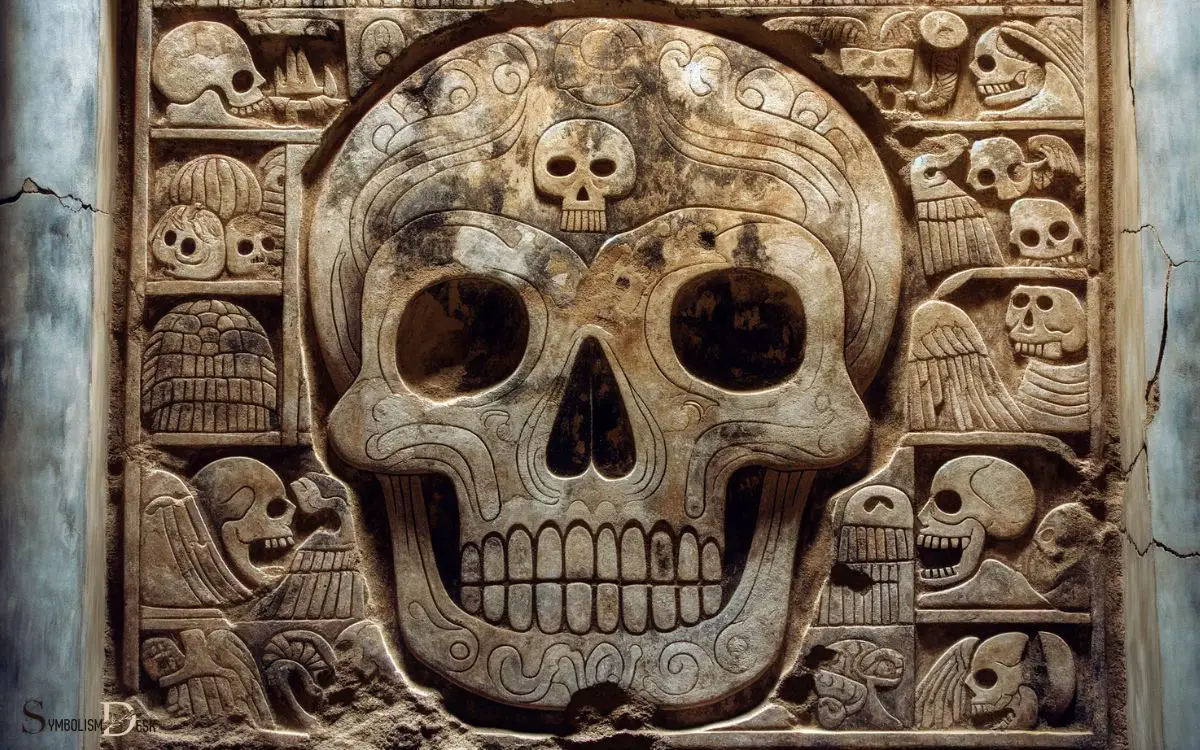
Skull symbolism in ancient cultures offers a fascinating insight into the diverse interpretations and spiritual significance attributed to this symbol.
From the Aztecs and Mayans to the Celts and Egyptians, skulls held a central role in rituals, art, and religious beliefs.
Exploring these ancient cultural perspectives sheds light on the deep-rooted spiritual and ritualistic meanings associated with the skull symbol.
Ancient Cultural Interpretations
Ancient cultures across the world interpreted the skull as a symbol of mortality and the cycle of life and death.
- In ancient Mesoamerican societies such as the Aztecs and Mayans, the skull held a significant spiritual meaning. It represented the concept of rebirth and was often associated with the deity of death and the afterlife.
- In Celtic culture, the skull was a symbol of transience, reminding people of the temporary nature of life. The ancient Egyptians also held the skull in high regard, viewing it as a vessel of wisdom and the seat of intelligence.
Across various ancient cultures, the skull was seen as a powerful symbol, representing the interconnectedness of life and death and the enduring cycle of existence.
These interpretations provided a foundation for spiritual significance and rituals centered around the skull in these societies.
Transitioning into the subsequent section about ‘spiritual significance and rituals’, it is important to delve into how these ancient cultural interpretations influenced spiritual practices and customs surrounding the skull.
Spiritual Significance and Rituals
Throughout various ancient cultures, the interpretations of the skull as a symbol of mortality and the enduring cycle of life and death profoundly influenced spiritual practices and customs surrounding this powerful symbol.
| Ancient Culture | Spiritual Significance |
|---|---|
| Egyptian | Symbol of regeneration and rebirth. Often used in funerary rituals to guide the soul to the afterlife. |
| Aztec | Represented the concept of life and death, and was used in rituals to honor the dead during festivals like Mictecacihuatl. |
| Celtic | Symbolized power, strength, and protection. Often used in rituals to communicate with the spirit world. |
| Tibetan Buddhist | Used in Kapala rituals to symbolize the transformation of consciousness and the transcendence of ego. |
| Norse | Associated with wisdom, guidance, and protection. Used in rituals to seek the blessings of ancestral spirits. |
Spiritual Meanings in Different Religions
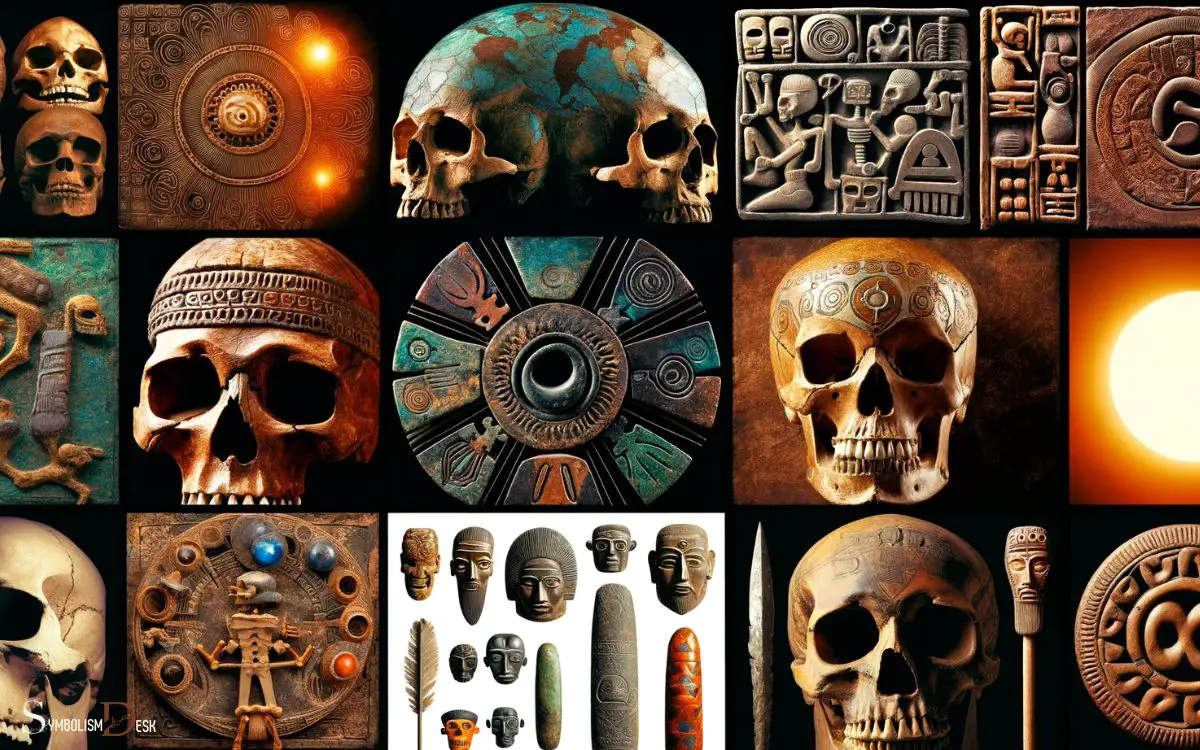
The spiritual significance of the skull varies across different religions, with each offering unique interpretations and symbolisms.
- In Hinduism, the skull represents the transcendence of the physical body and the impermanence of life.
- Buddhism views the skull as a reminder of the inevitability of death and the importance of living a meaningful life.
- In Christianity, the skull is often associated with the concept of mortality and the afterlife, serving as a symbol of resurrection and rebirth.
Skull in Hinduism
Skull holds significant spiritual symbolism in Hinduism, representing the abstract concept of impermanence and the cycle of life and death.
In Hinduism, the skull carries various spiritual meanings:
- Mundamala: The skull is associated with the concept of ‘Mundamala,’ which refers to a garland of skulls worn by Hindu deities, symbolizing the transcendence of time and the illusory nature of the physical world.
- Impermanence: The skull serves as a reminder of the impermanence of life and the transient nature of the physical body, encouraging individuals to focus on spiritual growth and liberation from the cycle of birth and death.
- Kapala: The skull is also linked to the concept of ‘Kapala,’ wherein it is used as a ritual implement in tantric practices, signifying the transformation of negative emotions and the attainment of enlightenment.
- Rebirth: It symbolizes the cyclical nature of existence, signifying death as a prelude to rebirth and spiritual evolution.
Symbolism in Buddhism
In Hinduism, the skull is a symbol of impermanence and spiritual transformation. Similarly, in Buddhism, the skull holds significant spiritual symbolism representing the concept of impermanence and the nature of existence.
In Buddhism, the skull, often depicted as a kapala, is a symbolic reminder of the transient nature of life and the inevitability of death.
It serves as a visual representation of the impermanence of all things, emphasizing the Buddhist teachings on the nature of existence and the importance of embracing change.
Additionally, the skull symbolizes the idea of emptiness, a key concept in Buddhist philosophy. It signifies the void of inherent existence in all phenomena.
This spiritual symbolism in Buddhism encourages practitioners to contemplate the nature of reality and the impermanence of life, fostering a deeper understanding of the interconnectedness of all things.
Skull in Christianity
Christianity also incorporates the symbolism of the skull in its spiritual teachings, reflecting on the concept of mortality and the afterlife.
In Christian symbolism, the skull represents the idea of mortality and the transient nature of earthly life. It serves as a reminder of the inevitability of death and the importance of spiritual preparedness for the afterlife.
Within Christianity, the skull is often associated with the concept of Golgotha, the site outside Jerusalem where Jesus was crucified, also known as the ‘place of the skull.’ This association emphasizes the redemptive aspect of Christ’s sacrifice and the triumph over death.
Additionally, in certain Christian traditions, the skull is a symbol of humility, reminding believers of the transient nature of human existence and the need for spiritual awakening.
Skull Symbolism in Contemporary Art
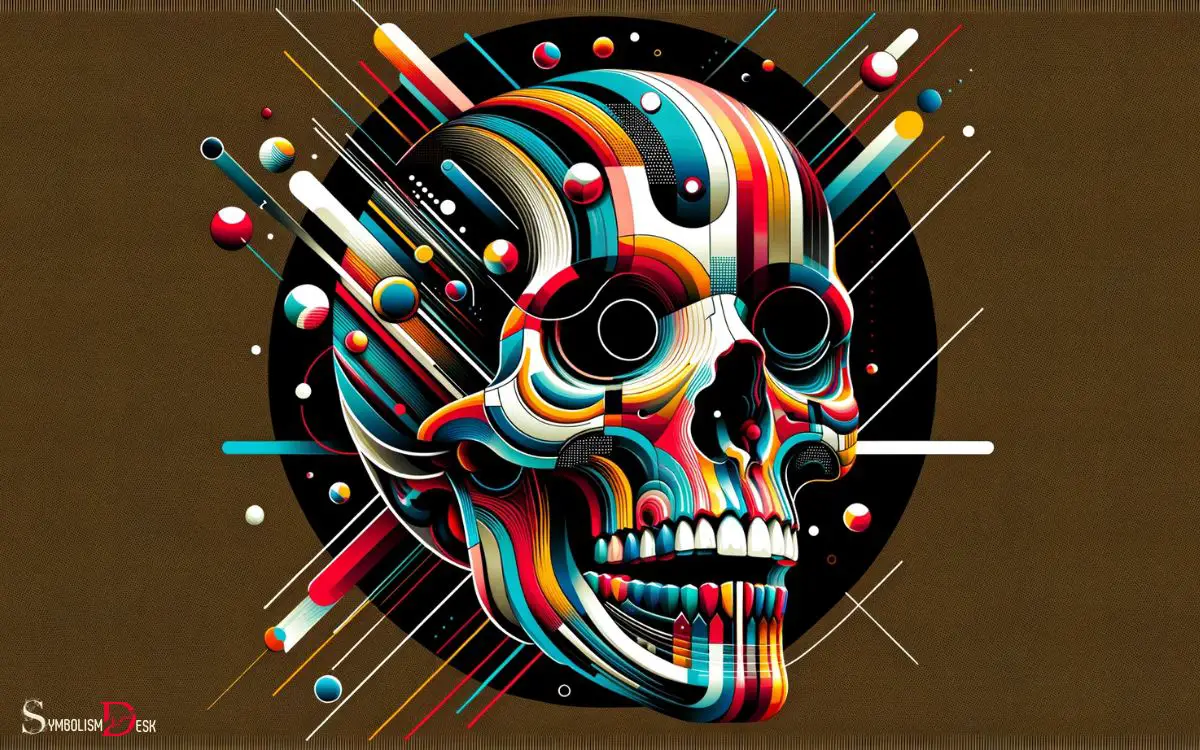
The incorporation of skull imagery in contemporary art reflects a cultural fascination with mortality and the transitory nature of life. Artists use the skull as a powerful symbol to explore themes of life, death, and the passage of time.
In contemporary art, the skull is often depicted in a variety of mediums, including paintings, sculptures, and mixed media installations.
This symbolism serves as a reminder of the fragility and impermanence of life, prompting viewers to contemplate their own mortality and the fleeting nature of existence.
The use of skull imagery in art also challenges traditional perceptions and taboos surrounding death, inviting viewers to confront and contemplate the inevitable cycle of life and death.
This artistic representation of the skull as a symbol of impermanence continues to captivate and provoke contemplation in contemporary society.
The Skull as a Reminder of Impermanence
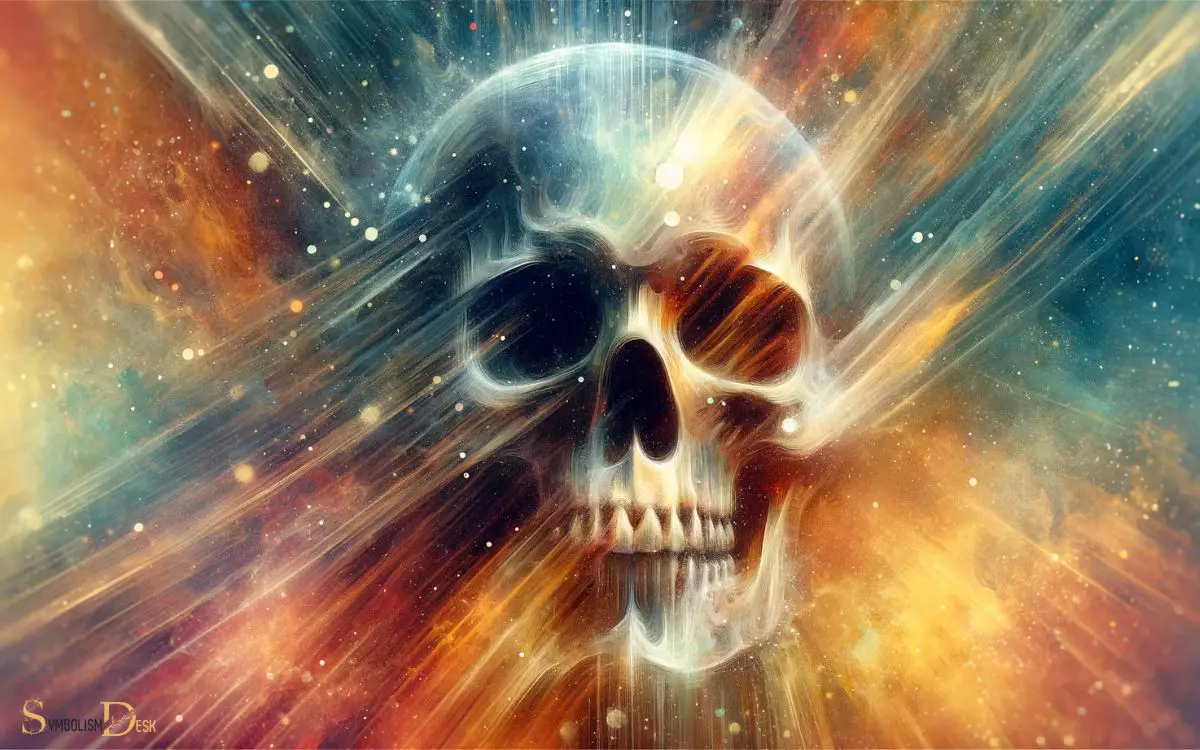
The incorporation of skull imagery in contemporary art reflects a cultural fascination with mortality and the transitory nature of life, prompting viewers to contemplate their own mortality and the fleeting nature of existence.
This fascination with the skull as a reminder of impermanence is deeply rooted in spiritual and philosophical traditions, serving as a powerful symbol of the transient nature of life.
The skull’s symbolism as a reminder of impermanence is further emphasized by its association with the concept of memento mori, a Latin phrase meaning ‘remember that you will die.’ This serves as a profound reminder to live life fully and mindfully.
Additionally, in various cultures, the skull is used in rituals and ceremonies to symbolize the cycle of life, death, and rebirth, further emphasizing its significance as a reminder of impermanence.
The Skull as a Symbol of Transformation
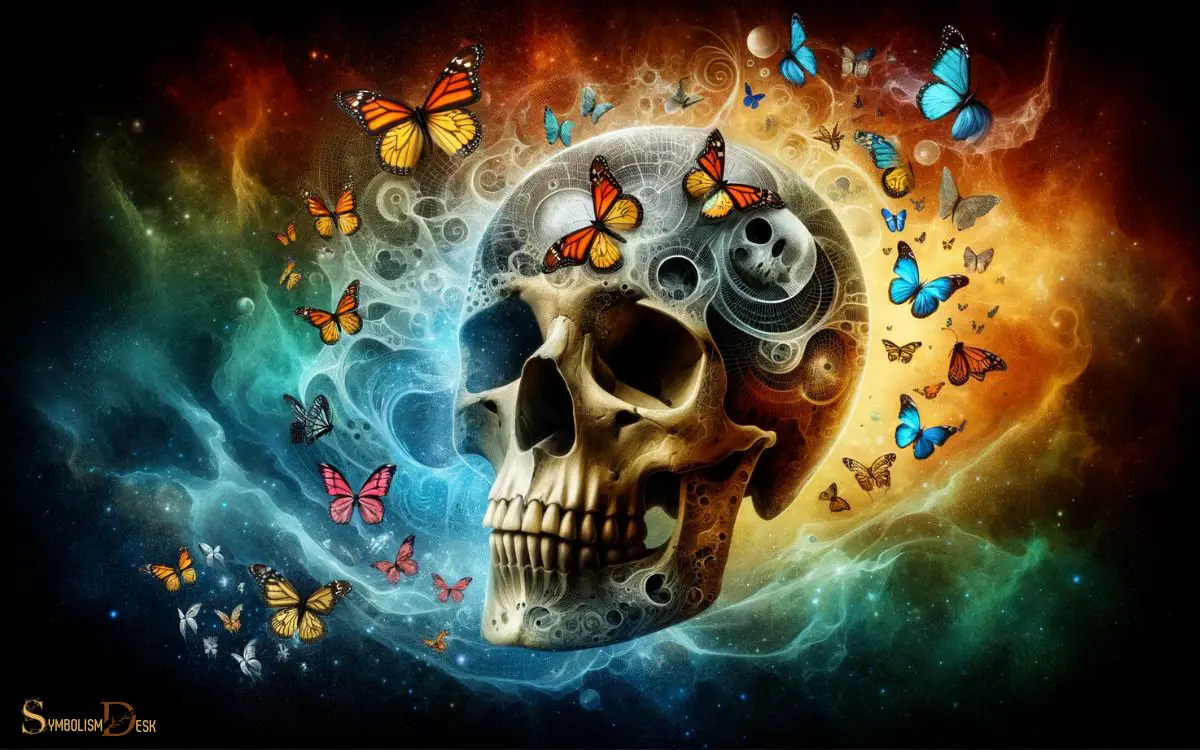
How does the skull symbolize spiritual transformation and renewal across various cultural and philosophical contexts? The skull, often depicted as a symbol of death, also represents transformation and renewal in many spiritual and philosophical traditions.
In various cultures, the skull is seen as a powerful symbol of change, evolution, and the cycle of life. It serves as a reminder of the impermanence of life and the constant process of transformation and rebirth.
The following table provides examples of how the skull is viewed as a symbol of transformation in different cultural and philosophical contexts:
| Cultural/Philosophical Context | Symbolism |
|---|---|
| Hinduism | Represents the transcendence of the physical body |
| Tibetan Buddhism | Signifies the impermanence of life and the transformative power of death |
| Aztec Civilization | Symbol of life and regeneration in the cycle of death and rebirth |
Are Skull and X Symbols Related in Spiritual Transformation?
The skull and X spiritual transformation symbolism are closely linked in various spiritual traditions. The skull represents mortality and the transient nature of life, while the X symbolizes the intersection of the material and spiritual realms. Together, they signify the transformative power of death and rebirth in spiritual growth.
Using Skull Symbolism in Spiritual Practices

Skull symbolism plays a significant role in various spiritual practices, embodying themes of transformation and renewal.
When used in spiritual practices, the skull symbol holds various meanings and purposes, including:
Memento Mori Tradition: In some spiritual traditions, skulls are used as a reminder of the impermanence of life and the inevitability of death.
This serves as a tool for practitioners to contemplate the transient nature of existence and to live more consciously.
Symbol of Wisdom and Knowledge: In certain belief systems, the skull is revered as a symbol of wisdom and knowledge.
It represents the idea that through death and rebirth, one gains a deeper understanding of life and the universe. This symbolism is used to inspire seekers to pursue spiritual enlightenment and inner growth.
Conclusion
The skull symbolizes various spiritual meanings across different cultures and religions. It serves as a reminder of impermanence and the cycle of life and death. Contemporary artists often use skull imagery to explore themes of mortality and transformation.
In spiritual practices, the skull can be used as a meditation tool to contemplate the transient nature of life. For example, Tibetan Buddhists use skull cups in rituals to remind practitioners of the impermanence of life.






